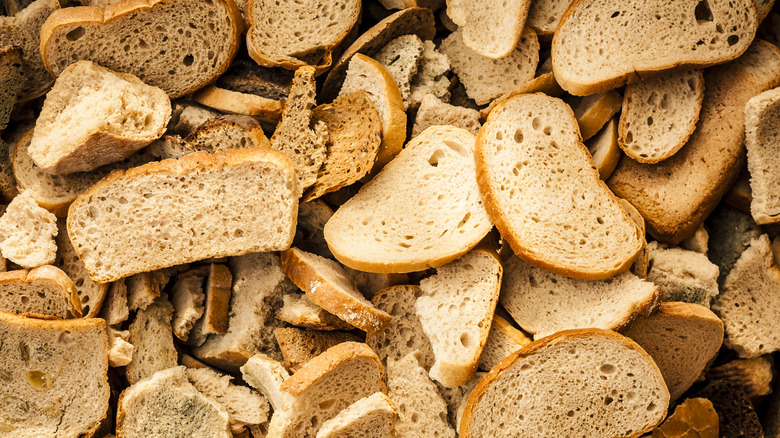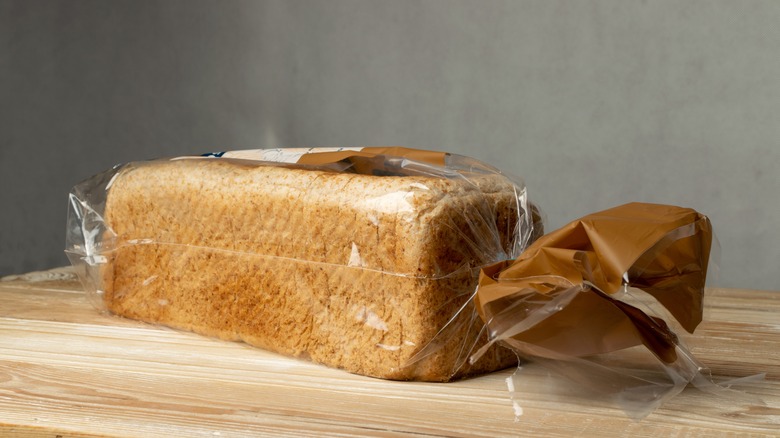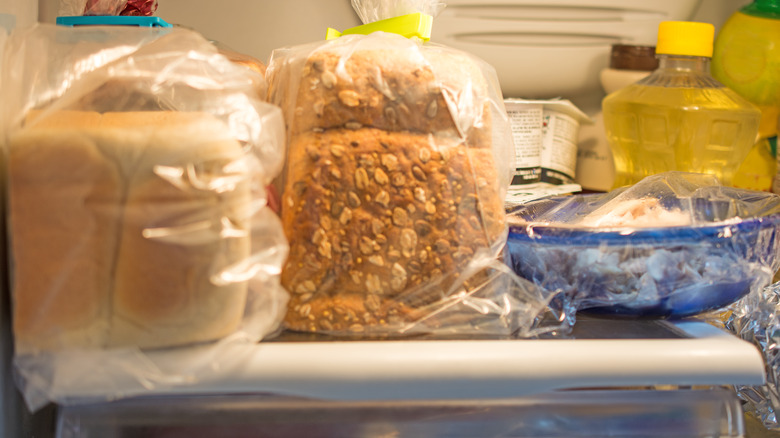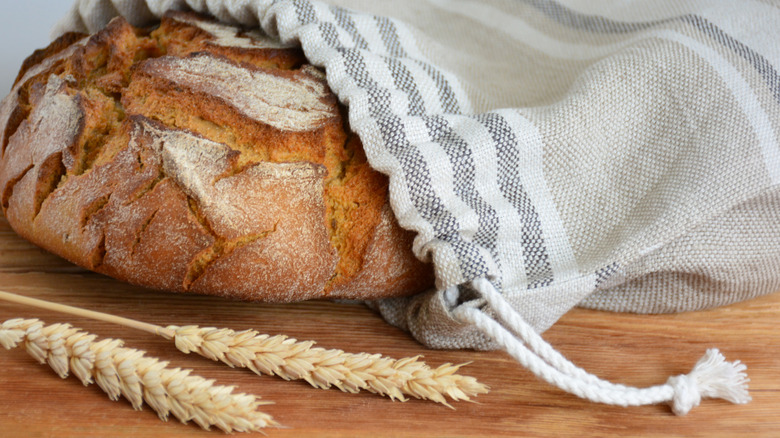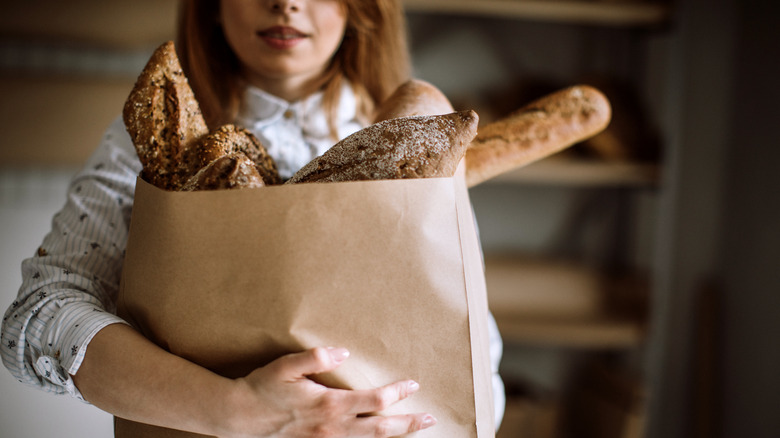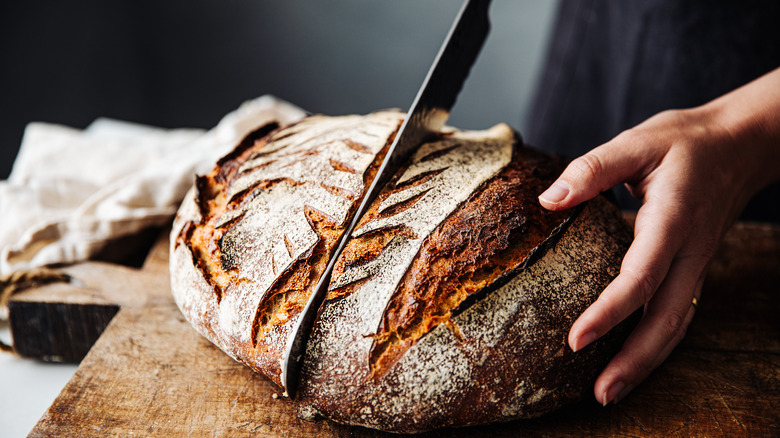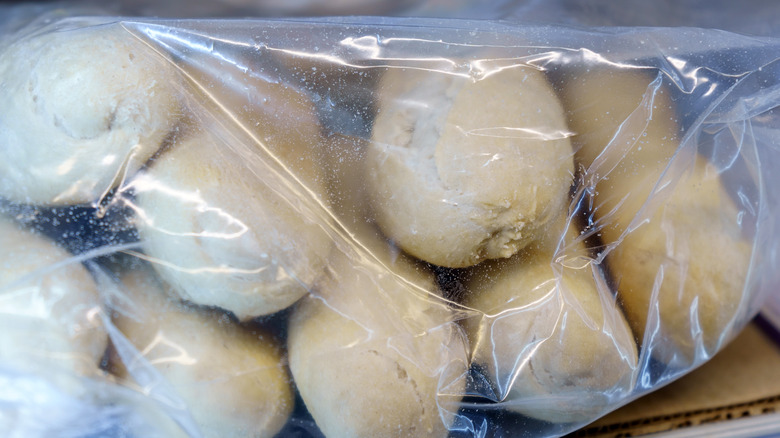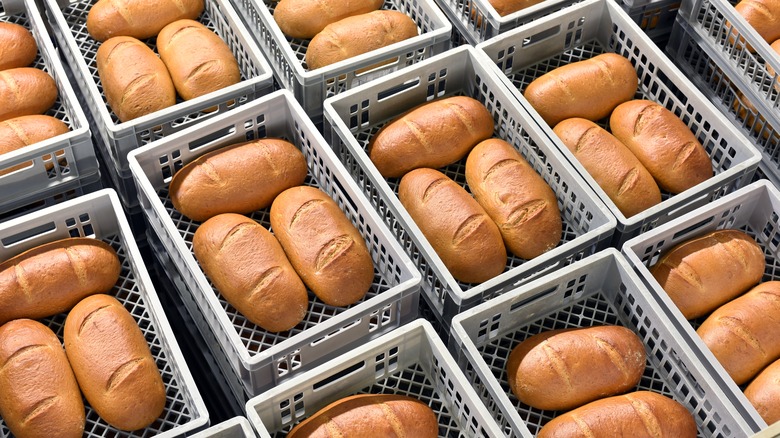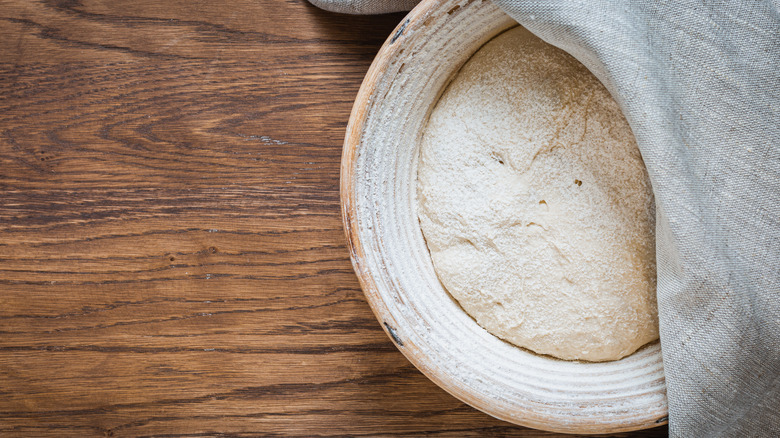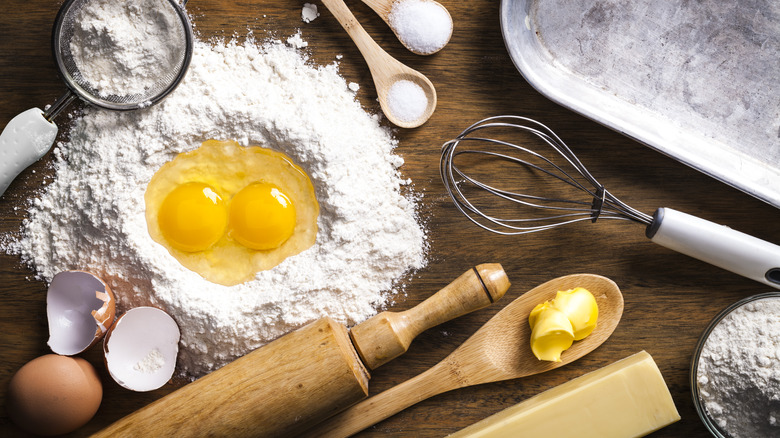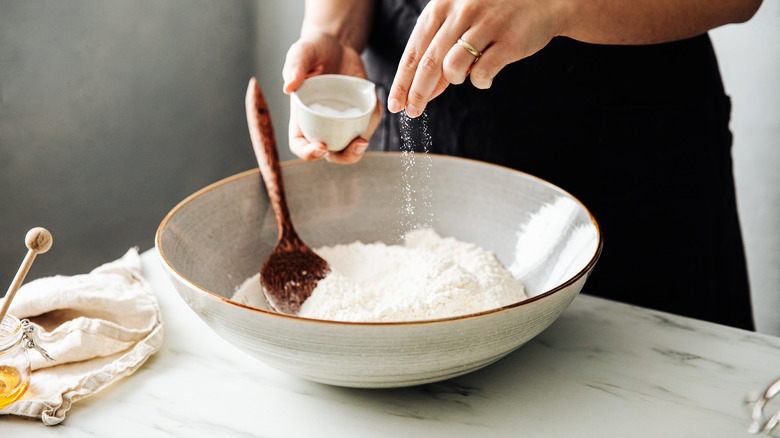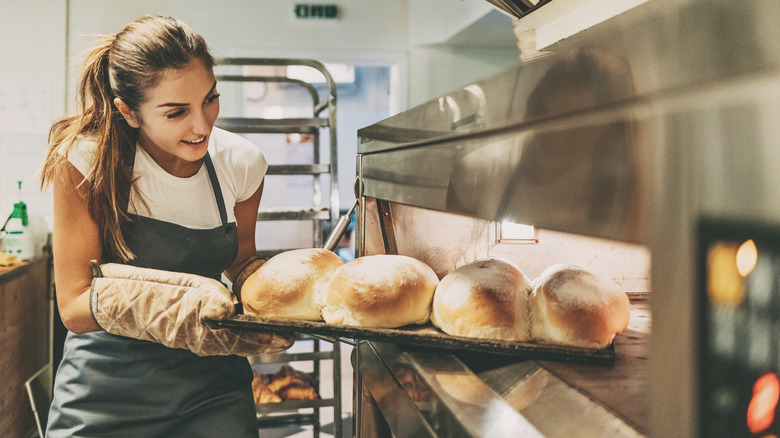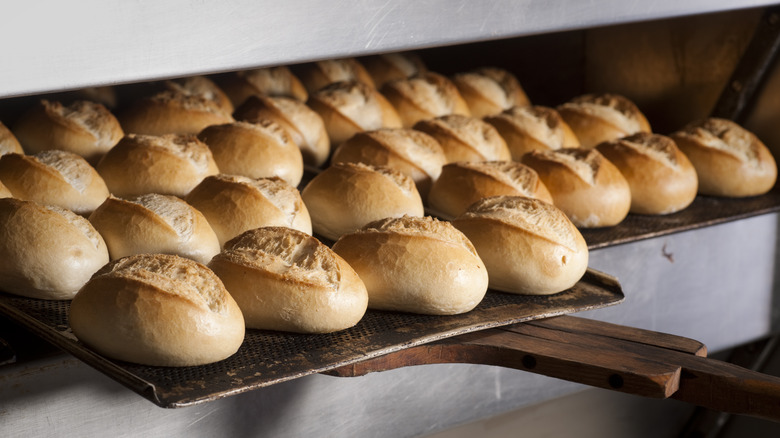12 Mistakes That Are Making Your Bread Go Stale Faster
Tough stale bread is often mistakenly thought of as just drying out. At the heart of bread staling is the behavior of starch. Bread contains amylose and amylopectin, types of starch. Upon baking, these starch granules swell by absorbing water, giving bread its soft texture. Over time, these starch molecules reconfigure and harden in a process known as retrogradation. Rather than mere water loss, bread staling involves the movement of moisture from the crumb (inner part) to the crust, rendering the crumb hard and the crust softer.
Mistakes that expedite bread staling include storing it in the refrigerator, which paradoxically makes bread harden faster. Not sealing it properly allows air to rush in, quickening the staling process. Many believe that plastic bags are bread's best friend, but in reality, they trap moisture, resulting in a damp crust and faster staling. Placing bread under direct sunlight might seem harmless, but it can cause it to heat up and stale more swiftly. Lastly, keeping bread in warm, humid areas might seem cozy, but these conditions are ripe for mold growth, undermining the bread's freshness. Dive deeper, and you'll find there's more to this story — some elements are less evident, while others are straightforward wisdom we often miss in our ever-churning sea of information.
1. Storing bread in a plastic bag
One Quora user shares their observation that, intriguingly, bread can become stale and firm in a bag without any noticeable moisture loss. While the bread feels as if it has dried up, the consistent weight of the bag indicates the water content remains unchanged.
While the plastic bag certainly has implications for spoilage, it also plays a significant role in accelerating the bread staling process. The trapped moisture, combined with temperature fluctuations and limited airflow, creates conditions that foster rapid starch retrogradation, leading to stale bread much faster than if stored in more breathable conditions.
Plastic bags, being less breathable than other storage mediums, trap moisture. The elevated humidity within the bag can accelerate the retrogradation of the starch. When the crumb of the bread becomes overly moist, the starch molecules find it easier to revert and crystallize, leading to a firm, stale texture in the bread much faster than in a drier environment.
A plastic bag does not insulate bread from ambient temperature changes. When bread is stored in such bags, especially in varying temperatures like in a kitchen, the fluctuations can lead to condensation within the bag. This added moisture can further intensify the starch retrogradation process.
2. Storing bread in the fridge
Storing bread in the fridge is a common misconception many adopt, thinking it will prolong the bread's freshness. However, in reality, the cold environment of the fridge can actually hasten the staling process.
The primary reason is tied to the behavior of starch molecules in bread. When bread is baked, the heat causes the starches, namely amylose and amylopectin, to gelatinize, meaning they absorb water and swell, providing the bread its soft and fluffy texture. As the bread cools and ages, these starches begin to revert to their original crystalline form, a process known as retrogradation. When bread is stored in the refrigerator, this retrogradation process is accelerated, causing the bread to feel stale faster than it would at room temperature.
The refrigerator is not just cold; it's also a relatively dry environment. This can cause moisture from the bread's interior (or crumb) to migrate to the surface or crust. Even though the overall moisture content might not change significantly, this redistribution can result in a crust that feels damp or rubbery, while the crumb becomes dry and crumbly.
Refrigerators house various foods, many with strong odors. Bread, being porous, can absorb some of these odors, negatively impacting its flavor. This doesn't necessarily contribute to staling, but it does affect the overall quality and palatability of the bread.
3. Not storing in a dry room temperature area
Storing bread at temperatures typical of a refrigerator, 0 to 5 degree Celsius or 32 to 41 degrees Fahrenheit, accelerates the staling process due to faster starch retrogradation. In these cooler conditions, the starches in bread swiftly revert to a crystalline form, leading to a harder texture in the crumb. Conversely, room temperature, being warmer than refrigeration but not as warm as hot environments, offers a more balanced condition, moderating the speed of starch retrogradation and thus slowing the staling process.
In humid environments, bread faces unique challenges. First, External moisture can make the crust softer while increasing the internal moisture of the crumb. This moisture imbalance doesn't simply "inflate" the crumb but rather can make it feel firmer, contributing to the sensation of staling. Additionally, the increased moisture content in the crumb promotes starch molecules' retrogradation. As explained previously in the plastic bag example, when starch molecules encounter excess moisture, they more readily revert and crystallize. This results in bread that is firmer and less enjoyable to eat.
4. Keeping bread in its original packaging
Many commercial breads come in plastic bags. As previously discussed, plastic can trap moisture, which can soften the crust and can potentially accelerate the starch retrogradation in the bread's crumb. In this scenario, the bread might feel stale faster due to its texture changing, even if the moisture content remains relatively constant.
Some bakeries offer bread in paper bags. Paper allows for more breathability, which can help to maintain a crusty exterior for certain bread types, like French baguettes. However, if left too long, bread in a paper bag might lose moisture to the surrounding environment, which can make it feel dry and hard.
Lately, we've also seen specialized bread bags that may resemble regular plastic bags but often come with minute perforations to strike a balance between retaining necessary moisture and allowing for adequate breathability. While they may extend the shelf life of bread beyond that of conventional plastic bags, over extended periods, bread may still experience changes in texture and taste indicative of staling.
5. Slicing bread prematurely
When bread is sliced, it exposes more of its surface area to the surrounding environment. An intact loaf has only its outer crust exposed, which acts as a natural barrier against the external environment. This crust is typically drier and more resistant to changes in moisture than the inner part of the bread, known as the crumb. When you slice the bread, the soft, moist crumb is exposed directly to the air.
The inner part of the bread, known as the crumb, is softer and has more moisture than the crust. Much like how materials like wood aim to balance their moisture level with the surrounding environment, the crumb also tries to match its moisture level with the air. So, when exposed to air, the crumb's moisture moves out to reach this balance, causing the bread to feel stale.
On the flip side, if the environment is particularly humid, the exposed crumb can absorb excess moisture. This additional moisture can create a conducive environment for the retrogradation of starch molecules. As previously discussed, the staling process is deeply intertwined with starch retrogradation, which involves the crystallization of these starches. When bread is sliced, exposing more of its crumb to ambient conditions, there's a potential for accelerated staling. In extremely humid conditions, however, the primary concern is often a soft or soggy texture.
6. Freezing without proper packaging
Freezing is a common method to extend the shelf life of bread. At sub-zero temperatures, the enzymatic reactions that cause spoilage are greatly reduced. However, freezing can influence the rate of staling, especially if the bread is not adequately packaged.
In the freezing environment of a freezer, the water content in the bread can undergo sublimation, where it transforms directly from a solid (ice) to a gas (water vapor) without going through the liquid phase. This means the bread can lose moisture directly to the cold, dry environment of the freezer. As a result, bread can become dry and exhibit signs of staling.
When bread is frozen, water within it forms ice crystals. Without proper packaging, these ice crystals can migrate and form larger crystals on the surface or in the bread's pores. When the bread is later thawed, these ice crystals melt, leaving behind a changed texture in the bread — often making it feel mushier or more crumbly, which can be mistaken as staling.
Bread without adequate packaging is prone to freezer burn, a condition that occurs due to the sublimation of water, leaving behind dehydrated patches of bread. This results in a dry texture and an off-flavor, adding to the perception of staling.
It's also worth noting that freezing can slow down but not halt the process of starch retrogradation, which is a primary mechanism of bread staling. When bread is thawed after freezing, retrogradation can continue and sometimes even accelerate.
7. Not consuming within recommended shelf life
When you consume bread past its recommended shelf life, you're essentially consuming bread that has undergone extended staling. This doesn't mean the bread has staled "faster," but rather that the ongoing staling processes have had more time to manifest. The recommended shelf life of bread is a time frame provided by manufacturers or bakers based on the period the bread retains its optimal quality – in terms of flavor, texture, and overall acceptability. After this period, changes become more noticeable and may impact the overall quality of the bread.
Bread staling is a natural and continuous process driven by starch retrogradation. Over time, the starch molecules in bread revert from their cooked state (a more amorphous structure) back to a crystalline state. This change results in the bread's crumb becoming firmer and less palatable. Even if the bread is kept in ideal storage conditions, starch retrogradation continues, albeit at a slower pace.
As bread ages, there's a redistribution of moisture within it. Typically, the crumb, which is the soft inside part of the bread, has more moisture than the crust. Over time, there's a natural tendency for moisture to migrate from the crumb to the crust, leading to a drying out of the crumb and potential softening of the crust. This moisture redistribution contributes to the sensation of staling.
8. Overproofing the dough and using too much yeast
Overproofing dough and using excessive yeast both affect the structure and texture of the bread. These factors can indirectly influence the rate of staling, making the bread seem stale faster when compared to properly proofed bread.
Overproofing causes the dough to rise too much. The gluten structure, which provides elasticity and strength, gets overstretched. When this happens, the bread can have larger, irregular air pockets after baking. An overproofed dough often results in bread with a denser or gummy texture. The dense regions can seem stale because they might be less soft and pliable than expected. Furthermore, the gummy texture can provide conditions that promote quicker staling. Overproofed bread might not brown as well or might develop a thinner crust due to exhausted sugars. A thinner crust might not act as an effective barrier to the external environment, thus possibly accelerating moisture loss or redistribution.
Excessive yeast causes rapid fermentation, which means the dough rises faster than desired. This can lead to uneven gas distribution, with some areas of the dough being under fermented and others over fermented. Bread made with too much yeast often has a coarse or open crumb. This larger cellular structure can make the bread seem stale faster, as larger cells can potentially lead to quicker moisture migration and uneven drying.
9. Not enriching the bread
Enriched breads have ingredients added to them that improve their texture, flavor, and shelf-life. Examples of enriching agents include fats (like butter or oil), eggs, milk, and sweeteners. When bread is not enriched with these ingredients, it can stale faster due to several reasons.
For starters, fats are known to help retain moisture in baked goods. They create a barrier that reduces moisture loss, keeping the crumb softer for a longer time. In the absence of fats, bread can dry out faster. Fats interfere with gluten development, making the bread's crumb softer and more tender. Without fats, the bread might have a tighter gluten network, which can be perceived as a harder, less palatable texture over time.
Both milk and eggs introduce additional proteins and fats into the dough. These not only improve the bread's flavor and color but also influence its texture and moisture retention. Milk and eggs can potentially slow down the staling process by lowering the pH of bread dough. A slightly acidic dough environment is unfavorable for starch retrogradation, per a 2020 study, which means the bread's texture remains optimal for a more extended period.
Sweeteners, especially sugars, act as humectants. A humectant attracts and retains moisture. By holding onto water, sweeteners can delay the drying out of bread and, thus, its perceived staleness. Sugars participate in the Maillard reaction during baking, which contributes to the browning and flavor development of the crust. A well-developed crust can act as a barrier, to some extent, against moisture migration and environmental factors that accelerate staling.
10. Not using the right amount of salt
The role of salt in bread-making is multifaceted, and it significantly influences various aspects of the dough, including flavor, texture, and the overall staling process.
Salt regulates the activity of yeast. By controlling yeast fermentation, salt ensures that the bread rises at the right pace, producing a fine, even crumb structure. Without the right amount of salt, yeast can act too quickly, which might result in larger air pockets within the bread. Such a structure can expose more surface area internally, potentially facilitating a faster rate of staling.
It strengthens the gluten network in the dough. A well-developed gluten network ensures an even and cohesive crumb structure, which can be instrumental in preventing quick staling. Without the right amount of salt, the dough might not achieve the desired gluten strength, potentially leading to a bread structure that stales faster.
Also, salt attracts and retain water molecules. By doing so, it can help maintain the bread's moisture over time, making the bread less prone to drying out and staling. If you skimp on salt, you might be compromising this moisture-retaining property.
Additionally, salt influences the temperature at which starches in the dough gelatinize (or cook). This process can impact the final texture of the bread and its susceptibility to staling. A lack of the right salt quantity might lead to suboptimal starch gelatinization, potentially accelerating staling.
11. Baking at the wrong temperature or time
Baking temperature and time have a profound impact on the internal structure, texture, and moisture content of the bread, all of which play a role in the bread's propensity to stale. The outer crust serves as a natural barrier, limiting the loss of moisture from the bread's interior crumb. When bread is baked at too low a temperature, it might not develop a proper crust. A weak crust can allow moisture to escape more easily, resulting in drier bread that feels stale. Conversely, baking at a very high temperature can lead to an excessively thick crust. While this might retain moisture initially, upon cooling, the moisture difference between the dense crust and the inner crumb might lead to moisture migration, promoting staling.
During baking, the starches in bread undergo gelatinization, where they absorb water and swell. This process sets the bread's crumb structure. Insufficient baking time or temperature might result in incomplete gelatinization, causing the bread to have a denser texture that can stale differently than fully gelatinized bread. On the other hand, overbaking can cause excessive moisture loss, leading to drier bread that seems to stale faster.
Bread dough contains enzymes that break down starches into simpler sugars, which can then participate in the Maillard reaction, giving the crust its characteristic brown color and flavor. However, if bread is underbaked, these enzymes might remain more active in the final product, leading to further starch breakdown post-baking, which can influence staling.
12. Not letting the bread cool properly
One of the pleasures of freshly baked bread is its contrast between the crispy crust and soft interior. Proper cooling helps in achieving and maintaining this contrast. The moist crumb of freshly baked bread naturally releases moisture as it cools, creating a humid internal environment. This causes the crust to absorb excess moisture, quickening the staling process. Other factors, such as stacking loaves or covering them, further trap heat and moisture, exacerbating this imbalance. Such interruptions not only diminish the crust's crispiness but also contributes to its starch reactions, leading to staling.
Upon cooling, the swollen starch granules in bread begin to revert to their more crystalline form through a process called retrogradation. This continues even during storage and is a significant factor in bread staling. When bread is not allowed to sit and cool after baking, such as when it's prodded or cut prematurely, retrogradation might proceed irregularly, accelerating due to the uneven release of steam and heat, thus affecting the rate at which the bread becomes stale.
Proper cooling of bread requires either positioning it on an open, airy rack or resting it on its side to facilitate airflow beneath, averting any moisture accumulation that might soften the underside. To preserve the crust's crispness, the loaf should be cooled to room temperature without covering, ensuring that the desired texture is retained.
